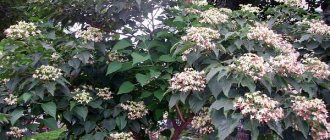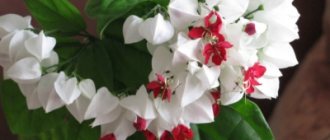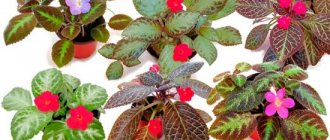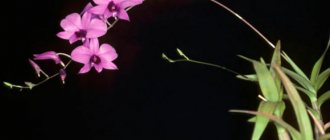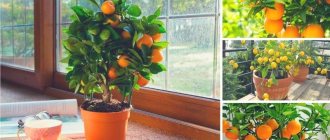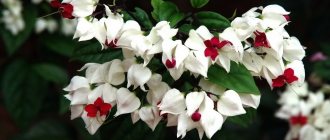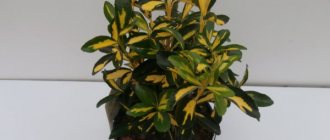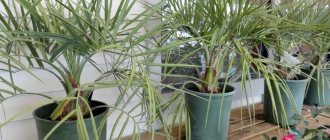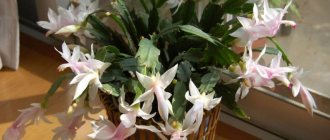Houseplant Clerodendrum - description
Clerodendrum belongs to the verbena family. There are quite a few different varieties of clerodendrum: there are vines, trees, and shrubs. Wild clerodendrums can grow up to four meters, but domestic ones rarely reach even one and a half meters.
In fact, these are perennials, but due to the fact that garden clerodendrum is difficult to winterize and remove from it, they are often grown as annuals: they squeeze out all the juices while the flowering period is in progress, and then, instead of sending them to wintering, they are cut and cut, growing a new plant . Or they just buy new ones.
In addition to traditional names - the flower of fate, innocent love - it is also called the flower of bloody drops for its characteristic bright red tips, or the “cleric flower”, because the flower bending down resembles a praying clergyman, and the shape of the buds resembles fingers gathered with a pinch, as for prayers.
What does clerodendrum look like?
The height that clerodendrum can reach depends on the species, but most often it is two to three meters. It has bright green foliage (its shade ranges from lighter to darker green), the leaves are large, usually oblong, but can be round, heart-shaped or ovate. The buds are small, collected in elegant bouquets, the tips of the petals are bright red. The color of the buds depends on the variety, but most often they are white. It also comes in purple, orange, pink, and red.
A characteristic feature of clerodendrum is its pleasant, delicate aroma. They even say that he can restore his sense of smell.
Where it grows - the birthplace of the plant
It was first discovered in the Canary Islands and is also distributed throughout South America, Asia and Africa.
How and when does clerodendrum bloom?
Blooms from April to October. It is highly valued for its decorativeness, abundance and duration of flowering.
Is clerodendrum poisonous or not?
No, it is absolutely not poisonous, even if your pet eats the leaf, it will not be harmed.
Description
Ugandan clerodendrum shoots in the natural environment quickly reach a height of 2–2.5 meters. Thin stems twine around nearby trees and bushes. The liana differs from other Verbenaceae by its pointed leaves, which have:
- length up to 10 cm;
- dark green color;
- elliptical shape;
- smooth edge;
- specific smell.
Four of the 5 petals of the small flower of the plant have a soft blue tint and resemble the wings of a butterfly; the concave blue or purple fifth resembles the abdomen of this fluttering insect.
In the very middle there are graceful stamens - long and curved, like antennae. The liana begins to bloom in April, stopping briefly only towards the end of autumn to form new buds. On young shoots, entire inflorescences are formed in the form of panicles.
How to care for clerodendrum at home
The easiest way to make any plant bloom at home is with meticulous and attentive care. If we talk about clerodendrum, then you need to take into account the following nuances:
Replanting after purchase
The rules for transplanting after purchase are the same as for a regular transplant. Replanting is necessary because store-bought soil is poor in nutrients, so plants do not live in it for long.
An important point: if you have other plants, then after purchase the clerodendrum is sent to a month-long quarantine, that is, it stands separately from the rest of the plants. This is necessary in order to prevent possible pest infestation. It happens that a flower arrives from a store infected. Then it is easier to cure one specimen than to drive out multiplied insects from your entire collection.
Lighting
Abundant, but scattered. Eastern and southern window sills are suitable, but it is necessary to cover the flower pot with a curtain to prevent sunburn.
Temperature
20-25⁰С. During wintering – not lower than 15⁰С.
Humidity
This is a tropical plant, so it loves moisture. So don't forget to constantly spray the air around it with a spray bottle. This is even more important than watering.
How to water clerodendrum
Traditionally for all plants: warm, settled water at room temperature. The frequency of watering depends on the time of year, but it is easier to overwater clerodendrum than to dry it out, and it is more important to keep the air around it moist, not the soil.
In summer
Two times a week.
in winter
Once a week.
Fertilizer and feeding
Feed during the flowering period (from April to October), once a week, with universal fertilizer for flowering plants. During wintering, feeding is stopped.
Pruning - how to prune clerodendrum correctly
Pruning at home is carried out in early spring. Dry branches, leaves, and dried buds are removed so that they do not take away the strength of the plant.
How to prune clerodendrum to bloom: cut off a third from the top. This stimulates the growth and more luxuriant flowering of the plant, since the root system, as it were, “concentrates” the distribution of vital juices throughout the remaining above-ground part. The ground part has become smaller, but there are no vital juices, which means it will bloom more abundantly.
You also need to pinch the clerodendrum so that it maintains the shape of the bush, because by nature it tends to stretch upward.
Landing instructions: rules and tips
Plant in early spring, when Clerodendrum has just begun to grow and the first leaves have appeared. If you need to replant at another time of the year, do it carefully using the transshipment procedure.
The substrate needs to be light and fertile. Most often this is forest soil, river sand. If the plant's shoots are too long, tie them so as not to break them when you plant them.
When replanting, you must choose a pot with a large hole. Be sure to add expanded clay to the bottom of the pot; the thickness of the mound should not exceed five centimeters.
Soil requirements
For clerodendrum it is better to choose slightly acidic soil. The soil mixture looks like this:
- fertile turf;
- dry peat;
- coarse sand;
- leaf soil.
The first one needs to be taken twice as much as the others.
Lighting and location
Clerodendrum is best placed on the windowsill of a window that faces west or east. You should not choose the north side, as the plant will not bloom, but if planted on the south side, there will be an abundance of sunlight.
The flower responds well to light, but in the hot season, you need to be extremely careful and avoid excessive exposure to sunlight.
The flower can get burned from strong direct rays of the sun. In winter, it is worth removing the flower from the windowsill and providing the required amount of light with a fluorescent lamp.
Planting and care in open ground
Allowed only if you live in the south and your winters are not harsh. Only one species can be grown in open ground - Clerodendrum bunge, known as Clerodendrum garden.
Choosing a place in the garden
Sunny, open, but it is desirable that the sunlight be diffused, because clerodendrum easily gets sunburned.
Planting in open ground
Planted in open ground in spring. It is necessary to make holes for the plant, fill the hole with a layer of drainage, cover it with soil, plant a flower there and fill the hole with soil, leaving no voids.
Watering
Watering itself is not abundant (in summer - once a week, and in winter the plant goes to hibernate), but the bush needs to be sprayed so that there is always a humid atmosphere around.
How to feed clerodendrum after planting in the ground
Complex mineral fertilizing twice a week during the growing season. In the fall, the fertilizing changes to one that contains iron.
Trimming
They are pruned, essentially, in the same way as homemade clerodendrum.
When to prune
In March-April.
How to trim correctly
- Use clean, disinfected instruments;
- Make cuts obliquely, at an angle of 45 degrees - from these it is easier for the flower to grow new shoots;
- You can shape the appearance of clerodendrum that is aesthetically pleasing to you, for example, trim it to the shape of a tree, removing the lower shoots, or vice versa, remove the upper shoots, forming a bush.
- Clerodendrum Bunge loves to grow in breadth. If you don’t like it, bury slate half a meter into the ground around it.
Wintering
When the temperature drops to 12-15⁰C, it is necessary to wrap the flower and spud its roots, otherwise it will freeze. Watering is reduced, but the soil should not be allowed to dry out, and spraying is maintained daily. Water and spray with boiled water, once every two weeks you need to add laundry soap (to the water for irrigation) to prevent pests and fertilizer containing iron (to the water for spraying) to prevent chlorosis.
Distinctive features of clerodendrum
The scientific description of the flower includes the following characteristic differences. They include:
- The leaf blades are decorated with a rich green tint. They are heart-shaped, the surface of which is decorated with quilted lines. Their length can reach from 15 to 35 cm. The lower part of the stem quickly becomes woody;
- Inflorescences contain up to 5 flowers, neatly collected in brushes. Outwardly they resemble a butterfly. Most often, clerodendrum flowers are white with a bright pink center;
- The stem should not exceed 100 cm. Regular pruning can reduce the load on the ornamental bush and maintain its impeccable qualities.
Reproduction of clerodendrum at home
In order to propagate clerodendrum at home, you will need the following tools:
- Soil mixture for young plants. You can make it yourself, at home: mix one part of peat, turf and sand.
- A large container for seeds and small ones for picking (seven centimeters in diameter, then eleven centimeters - this is for already grown plants, because their root system forms quickly).
- A sharp tool for separating a cutting or leaf - a knife, scissors. The tool needs to be sharp in order to cut a stalk or leaf, and not break it off or file it down, since clean cuts heal faster, unlike “lacerated wounds.” The instrument must be clean, and it must also be wiped with alcohol, since clerodendrum is prone to infection through mechanical damage.
- Crushed activated carbon or ash - you will sprinkle it on the cuts so as not to introduce infection into a fresh wound.
- The material for the greenhouse is polyethylene film or glass.
- Growth stimulator because the cuttings are rooted in water.
Can be propagated by cuttings, leaves or seeds.
Cuttings
It is easiest to carry out cuttings after pruning. The best time for this is spring-summer.
Separate the cutting so that it has a stem and its own pair of leaves. If there is a spine, that is also good, but not necessary. Immerse the cutting in warm, settled water with the addition of a growth stimulant and place it in a warm place illuminated by diffused sunlight. Add water if necessary, because the cutting will actively absorb it.
When roots appear, transplant the cuttings into small containers and cover with a greenhouse. The greenhouse must be ventilated as condensation forms: condensation has formed - remove the greenhouse, wipe the condensation with a cloth and put it back. Make sure that the soil in the container always remains slightly moist.
When new leaves appear on the sprout, transfer it to a larger container (transfer means taking it from the container and putting it in a new one, without clearing the earthen ball from the roots). There is no need to cover with a greenhouse anymore.
After a year, transfer it to a larger container with soil for adult clerodendrums and care for it as if it were an adult plant. But this year it is necessary to pinch the sprout a couple of times (remove stray leaves) so that it grows more luxuriantly.
Leaf
Rooting with leaves is unreliable; there is a 50/50 chance of rooting. However, they root with a leaf in the same way as with a cutting, they just take one leaf instead of a full-fledged cutting.
Seeds
When to sow seeds: late February - early March.
What should be done:
- Take a large container and fill it with soil mixture for seedlings (its composition is indicated above). Sow the seeds. There is no need to bury them, just pour them onto the soil.
- Cover with plastic wrap or glass.
- Place in a well-lit, warm place.
- Ventilate as condensation forms and moisten the soil with a spray bottle.
- The seeds will hatch in one and a half to two months.
- When the seedling has formed two pairs of leaves, you can transplant it into a separate small container (6 cm). When the seedling grows out of the container, it is transplanted into a new, even larger one, and cared for like an adult plant.
Reproduction
By cuttings
The easiest way to propagate a plant is by cuttings. It is held in the spring, when nature begins to wake up. The top of the stem is cut off by one third from the main mother bush. The shoot should have 3-4 internodes.
Planting material must be rooted in a container of water. Rooting in the substrate is also allowed. Perlite and peat are added to the soil. The stems in containers are grown in mini-greenhouses. Seedlings need a constant temperature above 20°C. Also, the stems are periodically ventilated to avoid rotting.
After good rooting, the flower is transplanted into a large container. Since an ornamental bush requires pruning for abundant flowering, propagation can be combined with this procedure. This way, the branches of the plant will not be lost, and a new ornamental bush can grow from them.
Seeds
Seeds are sown in February-March. A substrate of turf soil, fine-grained river sand and peat is required.
The seeds are placed in mini-greenhouses. They can be created from glass jars, cellophane or a plastic bottle.
Contain future seedlings in stable lighting. The seeds are ventilated periodically.
It is also necessary to maintain sufficient soil moisture. The first shoots appear 45-60 days after sowing.
After the seedlings have 4-5 leaves, they are transplanted into small cups.
It is important that one seed is in one container. If there are more than two seeds in a small pot, then they will not have room to actively develop and grow.
Containers should be no more than 6 cm in diameter. After the seedlings have developed and taken root, the seedlings must be transplanted into large containers. Then they begin to gradually accustom them to indoor conditions for adult ornamental bushes.
Transplanting clerodendrum at home
The procedure for transplantation is as follows:
- Disinfect the soil: put it in an oven heated to 100⁰C for half an hour, and then for two to three weeks in a well-ventilated place so that beneficial microorganisms grow in the soil.
- Prepare a new pot and soil (you will read more about them below).
- Pour three centimeters of drainage into the new pot. If necessary, immediately place a support (needed for old plants that cannot support their own weight).
- Carefully remove the plant from the previous pot, clean the soil from the roots, inspect the roots; if there are rotten parts, cut them off with a sharp, disinfected knife and sprinkle the sections with crushed activated carbon or ash. This must be done necessarily, because clerodendrum is susceptible to diseases that are introduced into its body through mechanical damage.
- Place the plant in the middle of the pot for drainage and fill in the remaining soil so that there are no voids left.
- Water the plant immediately.
Ready!
When to replant
Replant in early spring after pruning, then clerodendrum will best cope with the stress of replanting.
Reasons for transplantation:
- The pot became cramped. In young plants this happens annually, because the root system is actively developing, in older plants - once every two to three years. A symptom of a cramped pot is roots protruding above the ground.
- Another reason for replanting is depleted soil. This is indicated by the stopping of the growth of clerodendrum, its yellowing, faded, withered appearance.
- It may also be necessary to replant a plant due to diseases (for example, root rot) or pests that lay eggs in the soil, infecting it.
Priming
Slightly acidic, fertile. You can do it yourself. You will need equal parts of leaf soil, clay soil, peat moss and coarse sand.
You will also need drainage - expanded clay or crushed brick. This is necessary to ensure that the ground does not become waterlogged.
Pot
If you are replanting because the previous pot has become small, then the new one needs to be about a third larger and taller. The material of the pot is not particularly important.
A few words about care
Clerodendrum is a plant that can adapt to any interior, not only because of the variety of varieties. Proper pruning allows you to create a luxurious bush, an elegant vine or a graceful tree.
- The classic pruning method is used to keep the plant in good shape without creating a specific shape. At the beginning of the growth phase, the shoots are cut off, leaving 2/3 of the original length. The plant is freed from old, dry and weak branches.
- To create a neat tree, remove all shoots except the most powerful, leaving a trunk 0.6 m high. As it develops, maintain the desired shape of the crown by pinching the tops and cutting off excess branches.
- Lianas are pruned less frequently. Pinching and shortening shoots is used to maintain the beauty of the plant.
Correct and timely pruning promotes the growth and development of the plant and has a beneficial effect on flowering.
An important part of Volcameria care is replanting. The young bush is transplanted every year into a larger pot. As a rule, the diameter is increased by 1 - 2 cm. Adult plants require replanting once every three years.
There are no special requirements for the soil. The main parameters are breathability, low acidity, nutritional value. Traditional soil for flowering plants is suitable. Good drainage will ensure the circulation of air and water and relieve stagnation.
You can decorate your house not with clerodendrum alone, but, for example, with symmetrically located trees. At the same time, it is not at all necessary to run to the store for a new bush; you can propagate the plant yourself. Propagation by cuttings and seeds is favorable for clerodendrum.
The tree of destiny is an exotic living home decoration with a unique rich aroma and unusual appearance. Attention to clerodendrum is attracted not only by its unpretentiousness of maintenance, but also by its ability to create a summer atmosphere in mid-spring, thanks to its lush flowering. The basic rule of care is compliance with the conditions of maintenance, care and attention to the bush.
Clerodendrum diseases with photos and their treatment
The most common indicator that something is wrong with the plant is yellowing of the leaves. Yellowing comes in different forms, and so do the reasons for yellowing. Conventionally, they can be divided into reasons caused by care errors and reasons caused by diseases.
Yellowing that appears due to care errors is like this:
- Yellowing of the leaf edges means the root is damaged. You should remove the plant from the pot, inspect the root system and remove the damaged root.
- Yellow-brown spots of vague shapes are most often sunburn. You just need to move the flower further into the shade or cover it with a curtain, protecting it from direct sunlight. Then the plant will recover on its own.
- Small specks of different colors from yellow to brown are a fungus. The fungus, as a rule, appears in a humid environment, so the problem should be looked for in waterlogging: review the watering system, perhaps replant the plant, simultaneously removing rotten roots.
- The leaf vein has turned yellow - too much fertilizer or, on the contrary, depletion of the soil. In both cases a transplant is required.
Yellowing also occurs due to drafts (from which yellowing occurs very sharply, quickly), too small a pot (the plant is cramped inside, so it cannot develop normally; a symptom of a too small pot is roots protruding from the ground); stagnation of water in the pot due to excessive watering or, conversely, yellowing may be the result of too little watering.
Therefore, first of all, if the leaves of the clerodendrum have turned yellow, you need to reconsider the watering and bring it back to normal.
Yellowing also occurs due to disease.
- Alternaria blight.
Symptoms: black, dry spots on the leaves.
Why does this happen: Alternaria blight often occurs when two factors are combined: dirt around the clerodendrum (for example, you do not remove dead leaves, or there are dry leaves of other plants lying around) and direct sunlight. Also, sometimes Alternaria begins with infection during mechanical damage to the flower.
What to do: remove damaged leaves, treat with fungicides, resume normal watering, remove dirt and dry leaves if there are any around.
- Anthracnose.
Symptoms: round dark spots with a black border that gradually merge together. The stain soon dries, turns white in the center, and then a depression remains in place of the stain. Typically, such spots appear along leaf veins.
Why it appears: ideal conditions for the development of the disease are a combination of heat (22-27 degrees) with high humidity, plus mechanical damage or dirt, through which the disease enters the plant.
What to do: remove damaged parts, treat with fungicides, adjust the conditions so that they are not favorable for anthracosis.
- Septyrosis.
Symptoms: brown oblong spots with a dark rim.
Why it appears: high humidity, dry plant residues around and too much nitrogen fertilizers.
What to do: treat with colloidal sulfur, remove damaged parts of the plant.
- Leaf rust.
Symptoms: literally rust - bronze-colored growths on the leaves. At first these are small pads, but then they increase in size.
Why it appears: waterlogging and plant waste around.
What to do: treat with a preparation containing sulfur.
- Chlorosis.
Symptoms: leaves fade and white spots appear on them.
Causes of appearance: it can be infectious (appears due to pests) and non-infectious (appears for various reasons: lack of feeding or waterlogging of the roots).
What to do: spray or add Ferrovit Ferrylene to the water for irrigation.
- Root rot.
Symptoms: the plant wilts. The danger of this disease is that the rotting roots are not visible, because they are hidden underground. Therefore, it is important to inspect the roots every time you replant; if there are black, rotten parts, remove them.
Why it appears: waterlogging of the root system.
What to do: replant, when replanting, remove damaged roots and sprinkle the cut areas with crushed activated carbon.
- Stem rot.
Symptoms: dark spots on the stem. Appears due to excessive watering.
What to do: remove the damage, treat with a fungicide, reduce watering, then gradually adjust to normal condition (not to waterlogging).
- Powdery mildew or downy mildew.
Symptoms: white coating on the leaves. If the coating is fluffy, it is downy mildew, but the treatment for them is the same.
Why it appears: a combination of plant waste, humidity and cold. Clerodendrum strikes in the open ground in the fall.
What to do: cut off the damaged parts, treat with fungicides, adjust the watering regime.
Diseases and pests
If Clerodendrum is not provided with proper care, the following problems may arise:
- The leaves turn pale and dry at the tips . Watering is carried out with cold tap water. For humidification, use only settled or filtered water.
- The leaves are turning yellow . Lack of nutrients. Review the fertilizing regime.
- Leaves fall . The air in the room is dry. The plant is sprayed regularly.
- The buds are small, the shoots are elongated . There is not enough lighting. Install additional lighting.
- The lower leaves fall off and turn yellow . Drying of the soil. The flower needs to be watered urgently.
- Lack of flowering . The rest regime is not observed. In winter, they are kept at a temperature of 14-16 degrees.
Clerodendrum may be attacked by spider mites or whiteflies. At the first symptoms, wipe the leaves with a solution of soap or tobacco. And if the infection is severe, then they are treated with insecticidal preparations.
Clerodendrum is a unique plant that fits harmoniously into any room. The main thing is to follow all the rules of care and then it will definitely give you beautiful blooms.
Clerodendrum pests
Clerodendrum is a rather fragile and delicate plant, so it is important to periodically inspect it for pests, because the sooner you find insects, the higher the chance that the plant will not be harmed.
So, what pests are typical for clerodendrum:
Whitefly
Why it appears: unlike other pests, the whitefly loves warm and humid climates, not dry ones, and usually appears in such conditions.
Signs of appearance: clerodendrum stops growing, it does not bloom, then yellow spots appear on its leaves, and then a sticky coating. White scales appear on the underside of the leaves - these are larvae. You may also notice the whitefly itself - small white butterflies.
What to do: immediately isolate the clerodendrum from all other plants, since the whitefly is flying, it easily moves to its “neighbors.” Remove all existing insects using a cotton pad soaked in a soap solution, and then treat with an insecticide, for example, Aktara.
Prevention: ventilate the room, preventing the formation of conditions for whiteflies, and do not over-humidify the air around the plant.
Aphid
Signs of appearance: aphids are clearly visible on their own; they are small, round, light green bugs, often located along leaf veins and on the underside of leaves.
Why it appears: usually it is pure luck, there may just be an infected plant somewhere nearby (not even in your house), and the female has flown from there. But often aphids appear where it is warm and where it is dirty and dusty, so do not forget to ventilate the room and tidy up around the flowers, to prevent dirt from getting there.
What to do: wash the plant under a hot shower and treat with insecticides (Aktara, Tanrek, Iskra or similar). Folk remedies - ammonia, dog shampoo, a solution of soap with ash or just ash, but folk remedies are unreliable, it is better to use chemicals.
Spider mite
Signs of appearance: the main, characteristic sign that helps you understand that it is a spider mite in front of you - this is a thin white coating, similar to a cobweb, on the lower parts of the leaves. In addition, the plant does not bloom, the leaves turn yellow, the plant looks lethargic, and its growth stops.
What to do: the system of action is the same as with other pests: wash off the insects, treat with insecticides and replant the plant, since the spider mite lays eggs in the ground.
Why it appears: spider mites love dry, warm climates and dust, so plants standing near heating appliances are at risk, especially in winter.
Mealybug
Signs of appearance: a characteristic lumpy white coating, similar to lumps of cotton wool.
Reasons for appearance: dryness, heat. Mealybugs often attack clerodendrum after transplantation, when the plant has not yet adapted and watering is just being reduced.
What to do: wash the plant thoroughly with soapy water or wipe with alcohol to remove all insects. After this, wash your hands thoroughly and wash your clothes. After this, start treating with insecticides. Most likely, several different types of insecticides will be required; treatment is carried out once every week or two for one and a half to two months.
Shchitovka
Signs of appearance: light small growths, tubercles or scales on the leaves. This is a sign that the plant has been infected recently, because in the later stages, scale insects cover the entire clerodendrum plant, the leaves fall off (and before that they first turn yellow, then darken, dry out and become covered with a sticky coating).
What to do: The first step is to move the plant to a brightly lit place that is well ventilated and where there is no excess moisture in the air. After this, you need to remove all scale insects from the flower and treat it with insecticides. Most likely, you will have to treat with insecticides several times, and different ones, because scale insects have a natural defense mechanism against chemicals - a shield on the back - so they are not susceptible to insecticides. Cross-treatment is possible (two drugs at once).
Prevention: in the spring, when the scale insect larvae hatch, you can preventively spray clerodendrum with a preparation against scale insects. It is also important to regularly inspect all your flowers and quarantine the “new” ones (just purchased) in case they suddenly become infested with insects.
What you need to know about pests in general
- Most often they start by accident. These are insects, you can accidentally bring them on you from the street, they can fly out the window or get caught in the fur of your pet, especially if it is a dog and you are walking it.
- Most often, pests prefer a dry and warm microclimate, so they are especially common in winter, when the air in the apartment is hot and dry from heating devices. Another factor that contributes to the appearance of pests is dust, so it is important to periodically wipe it around the plants.
- When a plant (any plant) becomes infected with pests, the procedure is usually as follows: first, it is necessary to remove all existing insects using a warm shower or a cotton pad moistened with a thick soap solution; secondly, they are treated with insecticide medications; thirdly, as a rule, the plant has to be replanted, because pests usually lay larvae in the ground.
- Treatment with insecticides is often necessary two or three times. Between treatments, take a break of seven to ten days so that the chemicals do not damage the plant itself or leave chemical burns. If after treating with insecticides you still notice insects on the flower, try cross-treatment (with two drugs at the same time) or change the drug, because pests usually easily get used to the effects of chemicals.
- If you find pests on one plant, check the others immediately, because pests usually jump from flower to flower, looking for where else to get nutrients. For the same reason, the infected plant must be isolated from the rest so that the entire collection does not have to be treated at once.
Pests and diseases
The unpleasant smell of tropical vines comes from essential oils present in large quantities in the leaves, which drives away many insects from the plant. Not afraid of a specific aroma:
- whiteflies;
- scale insects;
- aphids and mites.
Advice! When pests appear, the clerodendrum should be washed with warm water and sprayed with a fungicide.
A perennial gets sick when care requirements are ignored. The leaves wither and turn yellow if the soil under the plant dries out. When there is a lack of moisture, the buds fall off. Drafts and cold provoke the formation of black spots on stems and shoots.
Important! Despite the fact that the vine loves the sun, hot rays can cause burns on the foliage. It takes on a brown tint.
Popular types of clerodendrum: photos and names
There are many different varieties, there is even a variegated one - with multi-colored petals. You will surely find something to your liking.
Clerodendrum Wallich (Valichi) or bridal veil
Delicate, white flowers, shaped like a lily or orchid, gently flow down on slightly curving stems, truly reminiscent of a bride's veil.
Clerodendrum Schmidt
Similar to the previous variety, but the flowers are smaller and much more abundant, like a snow-white fountain.
Clerodendrum Thompson
One of the most decorative varieties, it is most often grown. The buds are shaped like a palm gathered into slivers, topped with a small red star.
Clerodendrum aculeatum
And here the buds are open, small, soft pink in the middle, looking tender and fragile.
Clerodendrum brilliant or Splendence
An unusual variety: bright red, blooms in a lush stream of small flowers, shaped like tiny tiger lilies.
Clerodendrum Splash of Champagne or Indicum
This variety has flowers on thin, long peduncles, shaped like droplets or bells of lily of the valley.
Clerodendrum Bunge
The variety is suitable for growing outdoors. It has dark green foliage (the leaves are large, rounded), and small pink buds form lush balls.
Clerodendrum Ugandan or Blue Butterfly
The variety is a very beautiful soft blue color, very reminiscent of a more exotic version of violets, forget-me-nots or bluebells.
Clerodendrum Fragrant
This variety's buds are not bell-shaped, nor like lilies, but in the shape of tiny roses, which in turn form a fluffy, fragrant ball.
Clerodendrum Inerme
A rather modest variety compared to the previous one: only five petals per bud, the flowers are small, white, star-shaped, with long pink stamens.
Clerodendrum Calamitosum
A bit reminiscent of "champagne splash", but this variety is more often grown as a small, graceful tree.
Clerodendrum Quadriculare
An unusual variety: the buds grow on thin, long, bright pink peduncles, and the inflorescences themselves are white, which creates a bright, exotic combination.
Clerodendrum Most Beautiful
The variety is notable for its delicate clusters of scarlet-lilac buds, shaped like large drops.
Clerodendrum Prospero
Looks great in a pot; the shape of the clusters of white-yellow inflorescences is a bit reminiscent of bird cherry.
Clerodendrum Speciosum or Lovely
It resembles the “most beautiful” variety, but the color of the flower is slightly different: not scarlet-lilac, but rather a combination of bright red and soft pink.
Clerodendrum philippines
It resembles a “fragrant” variety, but the buds are more regular in shape, and their shade is not white, but rather has a slight white-pink tint.
Clerodendrum Musical Notes
A delicate, graceful variety, delicate and fragile, reminiscent of a more exotic version of lilies of the valley.
History, description and photo
The plant came to us from Malaysia and part of the African continent . Clerodendrum speciosum is a hybrid crop that appeared as a result of crossing two types of clerodendrum: Thompson and brilliant.
You can recognize this variety by its thin, long shoots of a reddish hue and large, hard leaves (which, moreover, have a slight edge). The foliage shape is heart-shaped and the color is rich green.
The main advantage of clerodendrum is its rapid growth rate . If all growing conditions are met, flowers bloom all year round.
Reference! The variety does not produce seeds, so Speciosum is propagated only by cuttings.
Below is a photo of a Clerodendrum speciosum flower.
What the clerodendrum flower brings to the house: signs and superstitions
This white flower with a red center is called differently, and all the names are poetic and beautiful: clerodendrum, which translates as “tree of fate”, volkameria (also spelled “volkameria”, without a soft sign; both names have a right to exist, it’s like John Watson and John Watson from English) or “innocent love”. Such a poetic plant simply could not help but acquire all sorts of signs and superstitions. What are they?
- As you can see, most often clerodendrum is associated with something good, positive - with fate, with love - therefore the signs associated with it are mostly positive. For example, it is believed that it attracts good luck and happiness, good mood, peace and tranquility in family relationships.
- Even if a white flower with red stamens has acquired pests, this does not mean something bad, as with other plants (other plants are considered pests, as if hinting to the owners that something terrible will happen soon).
It’s just that your pet is absorbing negative energy, and therefore weakened and was attacked by pests. This means that you need to pay more attention to your household, take care of them, sort out your quarrels, and, of course, take care of your pet so that it blooms again.
- The flower of fate softens the relationship between spouses, fills them with tenderness and care, and pushes towards reconciliation after a quarrel. If without mysticism, then the girl, of course, will be very pleased if her beloved gives her a beautiful flower with white and red flowers as a sign of reconciliation.
- There is such a sign: if an indoor flower with white and red flowers suddenly turns all its buds towards the door, this means that welcome guests will soon come to you.
- If a flower with red and white flowers suddenly withered unexpectedly, although there was no sign of trouble, this is sometimes associated with some kind of magical intervention: perhaps someone cast a spell on the owner of the plant, and the clerodendrum took all the negative energy for itself, could not cope and died. However, much more often this is still due to care errors.
- But if the clerodendrum plant is actively blooming, exudes a fragrant aroma and makes you happy with your health, it means that everything is calm and prosperous in the house, relationships are harmonious, everything is in order.
- Unexpected flowering in the middle of winter symbolizes the resumption of a relationship with a person with whom you broke up a long time ago, most often with an ex-partner, less often with a friend.
- And in general, the flowering of clerodendrum always means something positive: for example, good luck, the emergence of new feelings, the revival of love in a couple where passions have long subsided.
- If a white indoor flower with a red center appeared to you in a dream, then this is also a good sign. Most often, this portends new love, strong, sincere feelings. For women, this symbolizes a new boyfriend, and for men, it symbolizes a meeting with a woman whom he would like to call his wife.
- But if in a dream there was not only a clerodendrum flower, but also other people, it means that you will soon attend the wedding of these people or celebrate their birthday.
- They say that clerodendrum loves classical music and affectionate treatment. Scientists, of course, doubt that plants are capable of perceiving art or emotion, but why not say something nice about a flower that delights you with beauty every day?
Botanical description
Clerodendrum is an exotic plant, a representative of the Lamiaceae family. Grows in the tropical zone of Africa, Latin America, Asia, Australia and the Indian Islands.
This shrub has several names:
- in ancient Greece it was called the “tree of fate”; many signs and superstitions are associated with it;
- The ancient Roman name of the flower is Volkameria; it is also shrouded in a considerable number of secrets and legends.
About 400 plant varieties are known, only about 10 of which are suitable for indoor cultivation .
The plant is presented in the form of shrubs that can grow up to two meters, as well as in the form of vines, the maximum length of which reaches 4 meters. Characteristics of the plant:
- The flowers and leaves of the bush have a pleasant aroma, which depends on the variety.
- The color of the leaves is rich green and the length is about 20-30 cm.
- The flowers of most varieties are butterfly shaped.
- The lower part of the shoots becomes woody.
- Clerodendrum blooms from April to September, after which oblong orange fruits appear in place of the flowers. The size of the fruit is about 1 cm. Each fruit contains one seed.
- The plant has large bracts; they last for a long time until the coldest weather, when the dormant period begins. Therefore, the flowering appears to be continuous.
- Clerodendrum attracts with its spectacular flowers, which are collected in corymbose or racemose inflorescences and decorated with long stamens.
Clerodendrum is considered a hardy and unpretentious plant.
Pinching a bush helps give it a beautiful shape - standard, ampelous or bush-like.
Clerodendrum in the interior: photo
Photo
Below you can see a photo of the plant.
See other articles on our portal to learn more about the different types of clerodendrum, and also see photos of varieties: most beautiful, brilliant, Philippine, Bunge, Thompson, Ugandan, Inerme, Wallich or Prospero.
Kinds
There are more than 400 species in nature; about 10 are cultivated . The most common species: K. Thompson, K. Ugandan, K. Wallich, K. Philippine.
Thompson
To be precise, it should be called Mrs. Thompson's K, since the name mentioned in the title belongs to Helen Thompson. But the name stuck long ago, and even experts came to terms with the Russian-language inaccuracy.
This is the very first species to appear in the post-Soviet space. The plant immediately captivated exotic lovers with the unusual beauty of its white and red flowers in the form of heart-shaped lanterns , which often remain on the resting plant all winter.
Flowers of this variety are pictured below:
It was also found that the species adapts perfectly to dim indoor spaces in winter and to artificial or minimal natural light during the dormant period.
The only requirement, compliance with which practically guarantees good health and attractiveness, is air humidity . It shouldn't be low. At elevated temperatures, regular spraying is required.
When spraying leaves, you should avoid getting water on the flowers - this will cause them to rot, buds to fall off and early flowering.
This video talks about Ms. Thompson's flower:
Ugandan
Semi-deciduous liana, with medium-sized hard, slightly pubescent leaves, a quickly hardening trunk and unusual flowers in the form of blue butterflies. Not only the flowers, but also the leaves have a noticeable aroma. Delicate single flowers are scattered throughout the plant from early spring, with a second wave of flowering observed in autumn. Sometimes it blooms without a break until winter.
Look at the photo to see what Ugandan clerodendrum looks like:
It tolerates unfavorable conditions well , hard leaves do not suffer from them, but it develops better and blooms more abundantly in cool, partial shade and with abundant watering.
The Ugandan requires regular pruning of each branch immediately after flowering. This will stimulate the formation of new flower buds.
Useful video about this variety:
Wallich
The dense, durable, shiny leaves of K. Wallich attract attention at first sight. But the greatest advantage of the plant is the abundant clusters of snow-white flowers , which appear at different times of the year, but are especially lush in the fall.
The bushy plant periodically appears on sale. But the species does not always withstand winter conditions in the room without loss - it sheds its leaves . Owners mistake this phenomenon for the death of the plant and get rid of it. And in vain: in the spring, K. Wallich is covered with new foliage and is preparing to bloom.
Photos of Wallich are presented below:
Philippine
This is a very beautiful, but also quite rare indoor plant. A large tree can be grown into a single trunk, but it regularly produces root shoots, so it often looks like a bush .
Separated sprouts with roots tolerate removal from the mother pot well and quickly become the same large trees. The flowers of this species are rose-like , collected in a large fragrant inflorescence of flesh-pink shades.
Photo of Philippine clerodendrum:
Despite its fast growth and impressive size, Philippine clerodendrum should not be planted in a very large pot. When replanting, it is convenient to separate the root shoots and plant them in separate containers.
Speciozoom and Inerme
In addition to these most popular species, Speciosum and Inerme are occasionally found in indoor floriculture.
Abundantly blooming Beautiful (Speciosum) with lush red inflorescences:
Delicate Inerme - with single pale pink flowers:
The remaining species are not yet common, but plants of this genus have good prospects: nature has created many diverse, easily adaptable species.
How to grow a plant: step-by-step instructions
Seeds are a great way to grow plants, both indoors and in the garden. However, clerodendron is not always grown from seeds, since many varieties are not pollinated and, accordingly, do not produce a seed crop. But many species can still be grown in this way.
Before planting, seeds should be soaked in a solution of potassium permanganate.
It is recommended to purchase seed material in specialized stores , since manufacturers have already taken care of its quality. The seeds have already been treated with special antibacterial, disinfecting and stimulating solutions; they are completely ready for sowing.
But if the material is collected independently, it must first be disinfected by soaking it for some time in a weak solution of potassium permanganate, and then dry it well on a paper towel.
For good germination, the seeds are soaked in a growth stimulator. The manufacturer gives recommendations on the packaging for soaking time for each type of plant. After this, the seeds must be dried.
The algorithm for sowing clerodendron seeds is as follows:
- The substrate is prepared and poured into a shallow container without a drainage layer. It is recommended to sow at the end of winter or early spring, when photosynthesis is active.
- The soil is abundantly moistened.
- The seeds are sown in an even thin layer so that they are not planted too densely.
- The container is covered with a transparent material (film, plastic, glass), this method creates greenhouse conditions.
- The containers are placed in a warm place with good sunlight.
- The greenhouse shelter is opened every day for ventilation so that mold does not form and the seeds do not rot. The ventilation time at the initial stage is about 15 minutes.
- As the top layer of soil dries, it is necessary to moisten it with a spray bottle.
- The first shoots will appear in 2-3 months, during this period the ventilation time increases to 50-60 minutes, and after a few days the greenhouse is completely cleaned.
- Clerodendron needs picking; it is carried out after the appearance of the first four true leaves. The sprouts, together with the earthen ball on the root, are carefully transplanted into separate containers with a diameter of approximately 6-10 cm. Up to three sprouts can be planted in one such container.
- Rooting occurs quickly. Stronger plants can be planted in open ground or in separate pots already 2-3 weeks after picking.
Where to buy and cost of the plant
Today there are many specialized websites where you can purchase a beautiful flower without leaving your home, and it can also often be found in specialized stores.
Given the huge selection of clerodendron varieties, before purchasing, it is advisable to familiarize yourself with the photos and rules for caring for the plant, since there are subspecies that grow only in open ground.
The average cost of a young volkameria is 100-250 rubles. , but the price of a luxurious adult bush varies from 500 rubles. up to 1500 rub.
